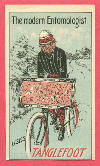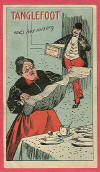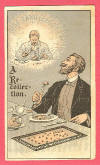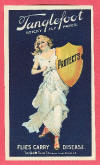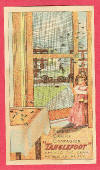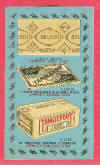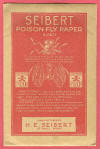 |
|
Flypaper
During the last half of the 19th century, flies were a major nuisance in and around people's homes. Before the advent of motorized vehicles, most transportation depended upon horses. Horses produced manure, which in turn produced more flies. Other unsanitary practices also added to the problem. This combined with the fact that few houses had window screens created a serious need for an effective method of controlling flies. As 1880 approached, there was an interest in producing a flypaper that would entangle flies when they landed upon it. Early attempts at producing flypaper in bulk were relatively unsuccessful because the sticky substance applied to the paper would either combine with the paper to form a gooey mess, or it would not last long on the shelf. The only reasonable means of obtaining flypaper was to have the druggist apply the sticky substance to the paper in the store at the time of purchase.
During the early 1880s, a Grand Rapids druggist, William Thum, assigned the task of developing a better flypaper to his four sons, Otto, Hugo, William, and Ferdinand. The brothers developed a sticky formula based on castor oil, resins, and wax, that had a much longer shelf life, and didn't saturate the paper backing. Tanglefoot flypaper was born. Several other companies produced flypaper, but none were as well-known as Tanglefoot. The tanglefoot formula was patented in 1887.
Tanglefoot was also a leader in advertising their product. See below for samples of their advertising flyers. In fact, in 1916, Tanglefoot even advertized on the outfield wall at Ebbets Field in Brooklyn. At that time, hall of famer Zack Wheat played outfield for Brooklyn. The advertisement read "In 1915 Wheat, Brooklyn, caught 345 flies. Tanglefoot caught 50,000,000,000 flies."
The advent of motorized vehicles, and the decreased dependence on horses for transportation, along with increased awareness of the need for better sanitation led to a decline in fly populations. The need for flypaper began to decrease during the 1930s, and then chemical controls, especially the use of DDT during the 1940s caused a further decline in flypaper usage. While some flypaper companies simply disappeared, the Tanglefoot company developed new alternative products, still primarily based on their sticky formula, and is still in existence today.
For a more detailed history of the Tanglefoot company, please see their website:
http://www.tanglefoot.com/history.htm
Tanglefoot Advertising flyers:
The Tanglefoot Products:
Other Fly Control Items:
|
Allan's Fly Brick |
Allan's Fly Brick |
Eureka Fly Plate |
|
David A. Rider
Professor of Entomology
North Dakota State University
202 Hultz Hall
Fargo, ND 58105
E-Mail: David.Rider@ndsu.edu
Published by the Department of
Entomology
Prospective students may schedule a visit by calling 1-800-488-NDSU.
